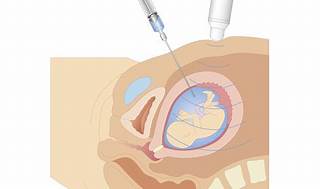A nurse is caring for a client who is at 33 weeks of gestation following an amniocentesis.
The nurse should monitor the client for which of the following complications?
Epigastric pain
Hypertension
Contractions
Vomiting
The Correct Answer is C

Explore
The correct answer is choice c. Contractions.
Choice A rationale:
Epigastric pain is not a common complication following an amniocentesis. It is more often associated with conditions like preeclampsia or gastrointestinal issues.
Choice B rationale:
Hypertension is not directly related to amniocentesis. It is more commonly associated with conditions like preeclampsia or chronic hypertension in pregnancy.
Choice C rationale:
Contractions are a significant complication to monitor for after an amniocentesis, especially at 33 weeks of gestation. The procedure can sometimes induce preterm labor.
Choice D rationale:
Vomiting is not a typical complication following an amniocentesis. It may occur due to other unrelated reasons but is not directly linked to the procedure.
Nursing Test Bank
Naxlex Comprehensive Predictor Exams
Related Questions
Correct Answer is A
Explanation
The correct answer is choice A. Limit oral feedings to 30 min in length.
This is because infants with heart failure have difficulty feeding and may become exhausted or dyspneic during prolonged feedings. By limiting the feeding time, the nurse can reduce the energy expenditure and caloric needs of the infant.
Choice B is wrong because weighing the infant every other day is not enough to monitor the fluid status and nutritional intake of the infant. The nurse should weigh the infant daily at the same time using the same scale.
Choice C is wrong because placing the infant in the prone position can compromise the respiratory function and increase the risk of sudden infant death syndrome (SIDS). The nurse should place the infant in a semi-Fowler’s position to facilitate breathing and decrease venous return.
Choice D is wrong because checking the infant’s oxygen saturation every 6 hr is not frequent enough to detect hypoxia or cyanosis. The nurse should monitor the oxygen saturation continuously or at least every 2 hr.
Correct Answer is D
Explanation
The correct answer is D. Remind the client to use the incentive spirometer.
Choice A rationale:
Observing the position of the suspended weight is beyond the scope of practice for assistive personnel (AP). This task requires assessment skills to ensure proper alignment and functioning of the traction system, which is the responsibility of the nurse.
Choice B rationale:
Checking the client’s pedal pulse on the right leg involves assessment and clinical judgment to evaluate perfusion and detect potential complications such as impaired circulation. This is not a task that can be delegated to AP.
Choice C rationale:
Asking the client to describe her pain requires assessment and interpretation of subjective data, which falls under the nurse's scope of practice. Pain assessment is a critical nursing function.
Choice D rationale:
Reminding the client to use the incentive spirometer is a non-assessment task that involves reinforcing previously taught instructions. This is appropriate to delegate to assistive personnel, as it does not require clinical judgment.
Whether you are a student looking to ace your exams or a practicing nurse seeking to enhance your expertise , our nursing education contents will empower you with the confidence and competence to make a difference in the lives of patients and become a respected leader in the healthcare field.
Visit Naxlex, invest in your future and unlock endless possibilities with our unparalleled nursing education contents today
Report Wrong Answer on the Current Question
Do you disagree with the answer? If yes, what is your expected answer? Explain.
Kindly be descriptive with the issue you are facing.
